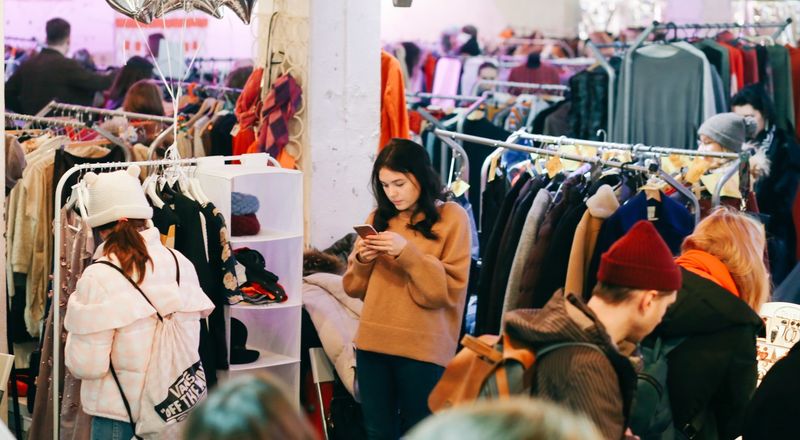How we can avoid buying fast fashion
Aoife talks about the damage fast fashion has on people and the planet, and how we can shop more sustainably

Fashion designer Yves Saint Laurent once said that “fashion fades, but style is eternal” and in a metaphorical sense, he was certainly correct. Passing trends are a dime a dozen these days. Where we used to see two distinct fashion seasons a year, we now see brands releasing new collections what feels like every other week. Conversations about sustainability are becoming more and more common, and so we must examine our wardrobes’ roles. With the reopening of many shops, now is as good a time as any to re-examine our shopping habits with a view to a more sustainable model.
The impact of fast fashion
Firstly, it’s important to have a grasp on what “fast fashion” actually is. Oxford English Dictionary defines fast fashion as “inexpensive clothing produced rapidly by mass-market retailers in response to the latest trends.” So, essentially, just about any clothes shop you can think of falls under the umbrella of “fast fashion” – it’s cheap, it’s trendy, and it’s mass-produced. The actual clothing produced to keep up with new trends does not fade quite as fast as the trends. Synthetic materials such as polyester, for example, can take up to 200 years to decompose. Then there is the damaging impact that plastic microfibers can have on marine wildlife, or the environmental impact of treating and dying fabric. Many fast fashion brands pay their garment workers terribly too. The increasingly disposable model of the fashion industry, created by the fast-fashion retailers that we all know and love, is destroying the planet. It’s estimated that if current trends continue, the fashion industry may be responsible for a quarter of global greenhouse gas emissions by 2050.
To counteract the damaging impact of fast fashion, we must shift our consumption habits toward a more sustainable approach known as “slow fashion” which is the opposite to all that is environmentally unfriendly in the fashion industry. Many different methods fall under “slow fashion” but some examples are as follows:
Charity Shops/ Thrift Stores
Charity shops, or the more Americanized “Thrift Stores” are a popular source of sustainable clothing, and are becoming increasingly favoured amongst young people as an environmentally friendly way to fulfil their shopping habits. As “normal” clothes shops are opening up, so too are the charity shops, and so now is as good a time as any to see what your local one has on offer. The prices are reasonable, and the quality is often better than you’d expect and you’re saving clothes from being thrown away after only a few uses. Not only that, but the money you spend goes directly to charity. It’s truly a win-win scenario!
Vintage
Vintage is, in some respects, the pricier cousin of charity shopping The exact definition of what constitutes as “vintage” is subject to debate, but a generally-accepted view is that it is any article of clothing over 20 years old. Vintage clothing, though harder to find and often more expensive than your typical thrifted piece, is generally of a high quality. The unique “one-off” nature of vintage makes it an appealing option to would-be trendsetters, and the cyclical nature of fashion means that it is trendier now more than ever. Why buy a brand new 1980’s inspired jacket, when you could save a genuine ‘80s jacket from landfill- a piece that you’re guaranteed no one else will have, at a fraction of the environmental cost?
Buy small, buy local
It is vital in a post-COVID economy to support local Irish businesses. The mass-produced nature of fast fashion is perhaps its most harmful element. While pricier, supporting local designers who work on a smaller scale is a more long term investment, both for your wallet and for the planet. Do your research to find Irish designers who fit your style- save the planet while stimulating the local economy.
Use what you have
It’s said that the most sustainable clothes in the world are the ones already in your wardrobe. Let’s be real, how any of us have clothes lurking in our wardrobe that we’ve worn once, maybe twice, only to be shoved to the back, never again to see the light of day? By utilising the clothing that we already have in our wardrobes, we are at once negating the need for new clothes and saving money. You can significantly extend the life of a garment by taking good care of it, and learning simple repairs. If you’re the kind of person who barely knows how to sew on a button, now is a great time to learn. YouTube has a wealth of tutorials at your fingertips – all you need now is patience and practice! Aside from basic repairs, there are lots of options for spicing up a once-loved garment. Embroidery, tie-dye, fabric paints… the only limit is your creativity.
We all have a part to play in the fight against fast fashion. Of course, nobody is going to be perfect, but it’s up to everyone to take small steps toward a more sustainable lifestyle, for the greater good.






